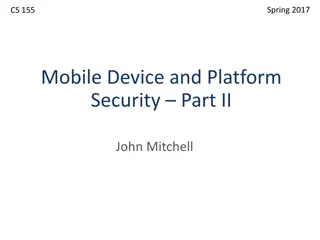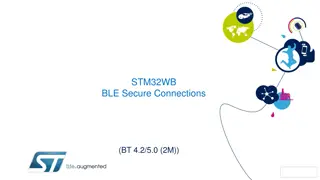Understanding BLE Security in EECS 582 - Spring 2015
Delve into the realm of Bluetooth Low Energy (BLE) security as covered in EECS 582 during the Spring of 2015. Explore topics including BLE refresher, attacks, improvements, authentication, and privacy. Gain insights into the BLE layers, connection establishment, encryption methods, and more to enhance your understanding of BLE security.
Download Presentation

Please find below an Image/Link to download the presentation.
The content on the website is provided AS IS for your information and personal use only. It may not be sold, licensed, or shared on other websites without obtaining consent from the author. Download presentation by click this link. If you encounter any issues during the download, it is possible that the publisher has removed the file from their server.
E N D
Presentation Transcript
BLE Security EECS 582 -- Spring 2015
Overview BLE Refresher Attacks Improvements Authentication Privacy Discussion
BLE: Quick/Simplified Refresh Application Layer GATT ATT L2CAP Link Layer Physical Layer
Link Layer Connections - Steps 1. Initiate Connection 2. Exchange keys <- Attack! 3. Authenticate 4. Send encrypted messages
Initiating a BLE Connection Peripheral advertises Initiator starts connection o hopInterval o hopIncrement o accessAddress o crcInit Initiator and peripheral move to next channel
Sniffing an on going connection Eliminate false positives (how do you know what is a packet) o Look for 16-bit header for empty packet, take prior 32-bits as AA o crcInit can be reversed, by running the packet through the LFSR in reverse (magic, magic, math, math...) o Access Address is set in each packet. Wait on a channel and observe subsequent packets, record time between Wait for a packet on two separate data channels
Encryption - BLE 4.0 & 4.1 Custom key exchange o Select TK (128 bit AES key) o Use TK to agree upon LTK What s TK? o Just WorksTM: key == 0 o 6-digit passkey: key in 0-999,999 o Out of Band: You re on your own.
BLE 4.2 - Secure Simple Pairing Elliptic Curve Diffie Hellman o 96 bits of entropy with P-192 or 128 bits with P-256 Protects against passive eavesdropping Does not protect against MITM Association models (anti-MITM) o Numeric comparison o Out of Band o Passkey Secure Connections Only Mode
Link Layer Encryption TCP/IP o No encryption o No authentication o Relies on application layer o Vulnerable to passive listener BLE o Node-to-node encryption o Impractical authentication (for many IoT) o Simply Secure is safe from passive listener
Could I be tracked? Device Address Randomization o Access Address generated by identity key (IRK) o IRK exchanged during bonding Do people use it? o We do not currently employ Bluetooth Smart in this capability. o ...we do not use randomize device address. o As far as we are aware, our two products that use BLE do not utilize this feature.
Summary Proven link-layer encryption scheme node to node (in 4.2) No protection against MITM without traditional I/O Option for randomizing device address
Wishlist Better way to do authentication o Many IoT class devices don t have classical I/O o How to I control what devices are connected to my gateway? o How can I control what gateways I connect to? Multihop communication o Do I trust the nodes in between the gateway and destination? o What happens if one of my devices is compromised? Do I trust my gateway?
References https://lacklustre.net/bluetooth/Ryan_Bluetooth_Low_Energy_USENIX_WOOT. pdf https://eprint.iacr.org/2013/309.pdf https://www.bluetooth.org/DocMan/handlers/DownloadDoc.ashx?doc_id=28643 9
What does IoT need? Confidentiality o I don t want people monitoring my habits at home ...but people can already see if my lights are on o Communication between nodes should be kept secret Authentication o We want to know what nodes are on our network and that they re legit. Preventing pivots o If a node is compromised, it should be hard for that node to pop other devices. Do I want people to know what devices I have in my house? Prevent neighbors from turning off lights General framework that different classes of devices can inherit from: medical IoT can specify something that fitness IoT needn t have.























